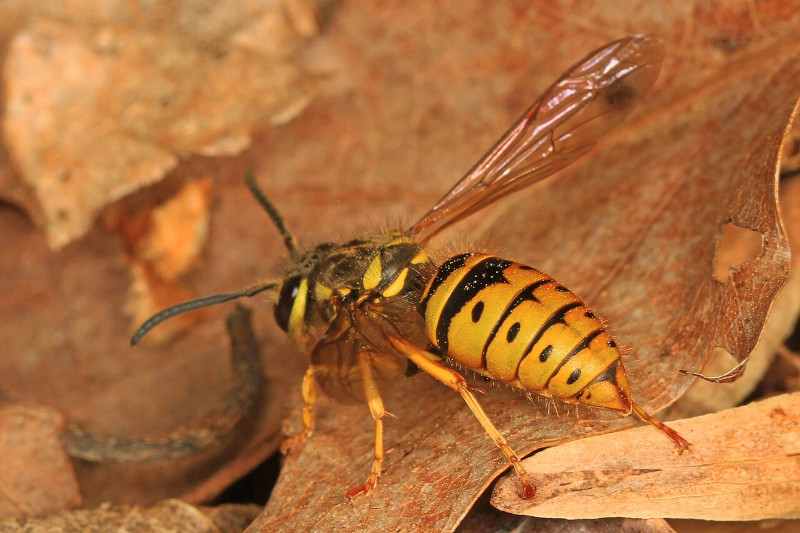
Eastern Yellowjacket Facts
- The most often employed common name for this beatiful and intriguing creation of evolution continues to be Eastern Yellowjacket. For now, it has only one other broadly accepted general title. That, though, is the very similar term eastern yellow jacket.
- Within the scientific community, however, the insect likely remains better known by its technical tag. Unfortunately, like so many such terms do, it’s a difficult appellation for the layperson to pronounce. That’s because its formal epithet is Vespula maculifrons.
- Due to ever-ongoing research, this marvel of Nature has held multiple different official names over the years. The invertebrate received the moniker it currently holds due to the efforts of the resepcted French naturalist, Robert François du Buysson, in 1905.
- Fortunately, the amazing Eastern Yellowjacket appears to be continuing to maintain a thriving population base. That pleasant trend also seems to hold true throughout its entire range. The IUCN thus presently has no listing for it on the Red List.
- The impressive species nevertheless still faces several potential threats to its continued existence. Like all forms of life on earth today, most of these stem from the actions of man. These dangers include the related perils of habitat loss and climate change.
Related Articles

Asian Giant Hornet



Eastern Yellowjacket Physical Description
The remarkable Eastern Yellowjacket typically quickly draws the attention of those individuals who see one. Yes, it’s true that this often occurs due to concerns over their aggressive nature. However, the insect also earns a measure of appreciation for its beauty.
Like many related creatures, it also displays a different version of the physiological characteristic known as sexual dimorphism. Since, like most wasps, it possesses a caste system, this trait manifests itself in several ways. That extends to markings and size alike.
Workers generally achieve lengths of approximately 0.49 in (1.25 cm). The head shows a combination of black and yellow markings. The abdomen does likewise, but its markings are specific. Thick bands of black cross the abdomen laterally, divided by thin yellow bands.
Males of the invertebrate usually achieve the same size as the workers. They, though, display a slightly different pattern of coloring. For them, the black bands show thickest near the thorax. Moving toward the anus, though, the yellow bands increase in thickness.
Queens achieve the greatest size of all members of the species. These attain lengths averaging roughly 0.71 in (1.8 cm). For her, the black bands are thickest near the base of the abdomen. Unlike the others, however, the bands are separated by yellow-colored dots.
The gender-based difference demonstrated by the Eastern Yellowjacket doesn’t simply end there, however. That’s because queens and workers possess a stinger situated at the end of the abdomen. Males completely lack this feature. Like many of its kind, the stinger is barbed.
- Kingdom: Animalia
- Phylum: Arthropoda
- Class: Insecta
- Order: Hymenoptera
- Family: Vespidae
- Genus: Vespula
- Species: V. maculifrons

Eastern Yellowjacket Distribution, Habitat, and Ecology
The beautiful Eastern Yellowjacket evolved as native to a moderately broad expanse of the earth’s surface. A small clue to the general location of that zone of habitation lies in the name of the Arthropod itself, though. In general, however, it’s endemic to North America.
Yet, it only inhabits specific portions of that greater area. Within the confines of the continent, it principally appears in the eastern sections of both the United States and Canada. In the former country, however, it also appears as far west as the Great Plains.
Thankfully, Nature blessed this marvelous Arthropod with a comparatively highly adaptable nature. The species therefore appears in a wide range of ecosystems. Given its territorial range, though, these all obviously fall within a range of temperate conditions.
It’s most commonly found in regions of hardwood forests, especially in close proximity to smaller creeks. It’s fond of building its nests on the banks of these. But, it also makes appearances in urban, suburban, and agricultural areas. It’s often seen in parks and yards.
The intrepid Eastern Yellowjacket constructs its nest underground. These structures usually aren’t buried deeply, though. Most have a covering of no more than 2 in (5 cm) of dirt. Even the deepest buried one’s rarely have a shield of more than 9.8 in (25 cm) of soil.
This wonder of evolution also feeds on a variety of nutrient sources. The small wasp both hunts live prey, usually small insects, and feeds on similar carrion. Yet, it’s also quite fond of fruit, honeydew, and nectar. Despite its sting, it has many predators, mostly mammals.
Species Sharing Its Range



Check out our other articles on 3 Awesome Antarctic Land Species, Amazonian Manatee, Macquarie Island, Southern Darwin’s Frog, Black Witches’ Butter, Cairns Birdwing, Philippine Cobra









Leave a Reply